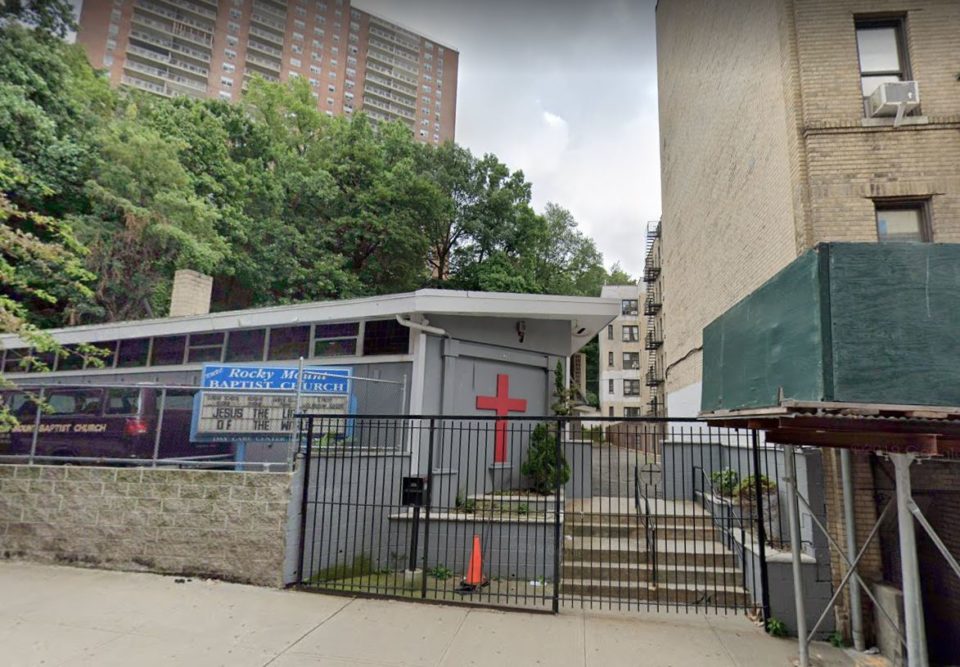
Nonprofit housing developer RiseBoro is adding 9 stories of affordable senior housing on this site in Inwood, formerly home to a Baptist church. (Google Maps)
Inwood, Hunter’s Point, and Woodlawn will soon be home to new units priced within reach of older New Yorkers of modest means. Along with five others being planned, the buildings will soon double the number of senior housing developments run by the nonprofit RiseBoro — but with waitlists already averaging seven years and the senior population quickly growing, staff say the need for affordable units will still dwarf the available supply.
“When you’re 80 years old, five to 10 years is an impossible amount of time to wait to become housing secure,” said Emily Kurtz, who has led affordable housing at Riseboro since 2017. “We’re at the very beginning of what they call the silver tsunami and it’s just going to become more acute as that population ages.”
Mayor de Blasio’s Housing 2.0 plan notes that the senior population, estimated at 1 million in 2010, is expected to increase to 1.4 million by 2040. While his signature initiative will build or preserve 300,000 affordable units by 2026, just 30,000 of those are intended to serve seniors.
There are signs that the senior housing crisis is already well underway. A 2016 study by LiveOn NY, a nonprofit that serves seniors, found more than 200,000 older adults were on a waitlist for housing subsidized by the federal Section 202 program — like the eight buildings Riseboro currently operates — and that the average wait time was between seven and 10 years. Section 202 buildings are highly attractive because they serve those with incomes less than half of the area median income.Tenants never pay more than 30 percent of their income towards rent.
“When a super low-income option comes up, that’s when you really see lines around the block,” said Katelyn Andrews, who leads public policy at LiveOn NY. “There’s just such a demand for those lower area median income targets because seniors are often living on fixed incomes, such as social security.”
However, for most of the past decade the federal budget has not included any funding for construction of new Section 202 buildings, leading the number of units to flatline even as the senior population has grown rapidly. Last year, the Department of Housing and Urban Development announced a total of $50 million in funds for new Section 202 construction, with a maximum award of $5 million per project.
An award of that size doesn’t go far in New York, say developers. Data from global construction firm Rider Levett Bucknell shows the city has the highest construction costs in the country. Furthermore, the federal Davis-Beacon Act requires developers using Section 202 funding to meet the “prevailing wage” standard for construction labor.
“The cost of construction has gone up so significantly that there’s just not enough subsidy to go around,” said Kurtz at RiseBoro. “We all want access to a limited resource, but the land price is going up and the number of units you can build is going down.”
With federal funding declining, the city has rolled out some of its own programs to fund senior housing, most notably the Senior Apartment Rental Assistance program, or SARA. The program offers construction financing to build units for seniors with incomes up to 60 percent of the area median income, and 30 percent of units must be set aside for seniors coming out of the shelter system. A 2018 study by researchers at UPenn and NYU projected that, without intervention, the number of seniors living in homeless shelters could triple to 7,000 by 2030.
But even apartments designed to be affordable can be out of reach for those without savings or a pension. In buildings run by Project FIND, another nonprofit that develops senior affordable housing, applicants must demonstrate they can pay rent of about $1,000. Most successful applicants pay using a subsidy for the formerly homeless or a Section 8 voucher, which can take years to obtain. Those who are unable to qualify for a subsidy often show up to an interview of years of waiting, only to be turned away.
“The process is complicated and it takes time,” said David Gilchrist, who leads Project FIND. “It’s quite agonizing and it can be sad when your expectations don’t work out.”
 Welcome to NYCBizNews.com, a site covering the city's economy as a crucial mayoral election looms. You will find stories on jobs and unemployment, manufacturing, tourism, small business and real estate. A separate section takes the pulse of the city's emerging tech sector. The site is produced by reporters at the New York City News Service and the CUNY Graduate School of Journalism. Email your comments to greg.david@journalism.cuny.edu.
Welcome to NYCBizNews.com, a site covering the city's economy as a crucial mayoral election looms. You will find stories on jobs and unemployment, manufacturing, tourism, small business and real estate. A separate section takes the pulse of the city's emerging tech sector. The site is produced by reporters at the New York City News Service and the CUNY Graduate School of Journalism. Email your comments to greg.david@journalism.cuny.edu.